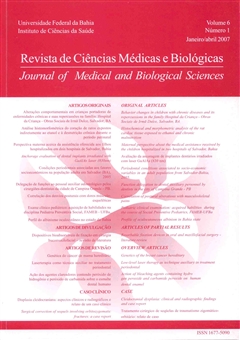Action of bleaching agents containing hydrogen peroxide and carbamide peroxide on human dental enamel
DOI:
https://doi.org/10.9771/cmbio.v6i1.4171Keywords:
Hydrogen peroxide. Carbamide peroxide. Dentifrice. Dental enamel.Abstract
The increasing demand of modern society for aesthetic dental procedures has found reply in dentistry that has been providing options for dental bleaching, using gels that may be auto-applicable or exclusively manipulated by professionals, either photo-activated by led or laser/led or not, or even incorporated to dentifrices formulas. Apparently less aggressive to mineralized structures, the available bleaching agents contain: hydrogen peroxide, carbamide peroxide and sodium perborate, the last one indicated for endogenous bleaching procedures in pulped teeth. In the concentration of 10%, auto-applicable, the carbamide peroxide is considered the gold standard substance by FDA. The sprouting of injuries in the morphology of the enamel, especially the hipersensitivity, has justified, also, the fluoride-therapy and the application of infra-red laser, amongst other procedures. It is not consensual among researchers if the severity of the injuries on the surface of dental enamel, detected by electronic microscopic scanning and caused by the action of these products, has clinical relevance. This paper aims to discuss the effect on human dental enamel resultant of the application of the hydrogen peroxide and carbamide peroxide, bleaching materials that constitute dentifrices and gels.Downloads
Download data is not yet available.
Downloads
Published
2007-01-01
How to Cite
Araújo, D. B., Lima, M. J. P., & Araújo, R. P. C. de. (2007). Action of bleaching agents containing hydrogen peroxide and carbamide peroxide on human dental enamel. Journal of Medical and Biological Sciences, 6(1), 100–121. https://doi.org/10.9771/cmbio.v6i1.4171
Issue
Section
Review Articles
License
The Journal of Medical and Biological Sciences reserves all copyrights of published works, including translations, allowing, however, their subsequent reproduction as transcription, with proper citation of source, through the Creative Commons license. The periodical has free and free access.


